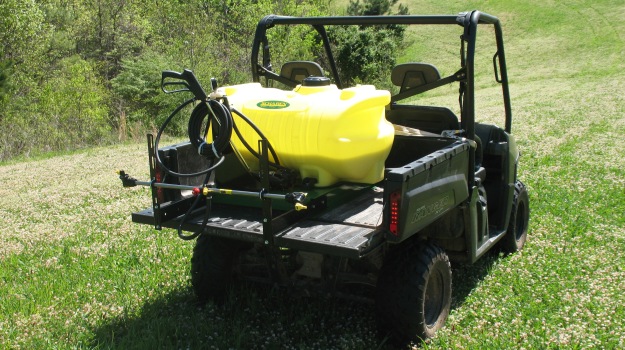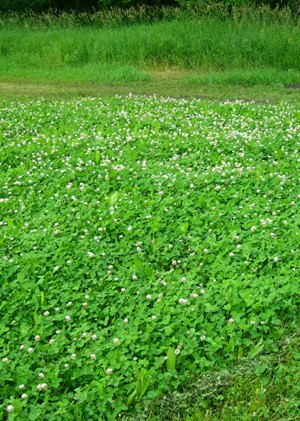
The facts on mixing herbicides
By Austin Delano
With all the herbicides on the market I am frequently asked what each can be used for, which ones can be mixed and what can be added to them to make them more effective. It definitely saves time and can be very helpful to be able to mix herbicides and spray multiple herbicides in one application. Here are a few of the more common herbicides used in food plotting and some do’s and don’ts when tank mixing.
One of the most common questions on mixing herbicides is when spraying legumes with a grass selective herbicide, can I add 2,4-DB for broadleaf control and “kill two birds with one stone?” The answer is yes, but be careful and READ THE LABELS! Most everyone is familiar with spraying grass selective herbicides over their legumes, whether it is clover, alfalfa, beans, peas, vetch, etc. For these grass selective herbicides to be effective a surfactant should be added to the tank mix. These surfactants will increase the efficiency of the herbicide and is critical for good grass kill when using Select (clethodim), Poast (sethoxydim), or any of their generic equivalents.
It is usually recommended to use a surfactant and not a crop oil when mixing Butyrac (2,4-DB) and a grass selective herbicide. Here is the problem when adding 2,4-DB to your tank mix with a grass selective herbicide and a surfactant. The added surfactant also increases the effectiveness of the 2,4-DB and can burn and temporarily injure the crop you are trying to protect if you were to use too much of the surfactant. It is recommended that you do not use more than 1.5 quarts per acre of 2,4-DB when mixing with a grass herbicide. This is why it is important to read the labels of both herbicides you will be spraying and specifically the sections for mixing compatible chemicals.
A common spraying practice in warm season food plots such as corn or sorghum, is to add a pre-emergence chemical to a pre-planting burn down tank of glyphosate. These pre-emergence herbicides fight the growth of new weeds after a crop is planted by preventing the germination of seeds by inhibiting a key enzyme. For instance, Atrazine is widely used just before a corn crop is planted to control broadleaves and grassy weeds through the growing season. Atrazine is a very effective herbicide and is often essential to a row crop operation to obtain maximum yield, however due to its residual effects, it can have a negative effect on many other common food plot seeds. The residual effect of many pre-emerge herbicides can keep some follow up plantings from ever germinating, and in some cases the seed germinates but plant growth and performance is very poor. This is one of the reasons that Round-Up Ready crops are so popular, there is no residual effect on the soil after application. The lesson here is to always check the label on any herbicide you plan on using. Its residual effects could alter your future planting choice.
 Another very common herbicide used in the farming for wildlife world is Round-Up (glyphosate) or any generic equivalent. 41% Glyphosate is used for post emergence broad spectrum weed control in many row crops and is also used widely for pre-planting burn-down. Broad spectrum is a term used meaning it is non-selective and will kill most all grasses and broadleaved weeds. Since glyphosate is basically an all-in-one herbicide, rarely are other chemicals mixed with it, however there are a couple things you can add to increase efficiency.
Another very common herbicide used in the farming for wildlife world is Round-Up (glyphosate) or any generic equivalent. 41% Glyphosate is used for post emergence broad spectrum weed control in many row crops and is also used widely for pre-planting burn-down. Broad spectrum is a term used meaning it is non-selective and will kill most all grasses and broadleaved weeds. Since glyphosate is basically an all-in-one herbicide, rarely are other chemicals mixed with it, however there are a couple things you can add to increase efficiency.
Increasing the effectiveness of your glyphosate can have a host of benefits. It can allow you to use a lower rate of chemical which saves you money as well as reducing the risk of encouraging weeds resistance to glyphosate. AMS (ammonium sulfate) has become my favorite thing to add to my burn down tank to really get a good kill. The AMS is especially helpful when using hard water for spraying. Many times water used for spraying at farms is well water and is by nature hard water. Well water and city water often contain high amounts of Magnesium, Calcium, and Iron. This hard water can reduce the effectiveness on emulsifiable concentrate (EC) herbicides. AMS comes in a liquid form and also in a fine granular form that mixes easily in your tank. Ammonium sulfate not only helps out in the effectiveness and efficiency of glyphosate, it is also good fertilizer for your field. One of the few times glyphosate may need another herbicide added to it is for an effective kill on heavy overgrown fields with woody plants such as briars, small trees ,and shrubs. In this case I like to add 2,4-D to the tank to really knock down the heavier brush and woody plants.
There are many herbicides available and some are great for use in food plots to control weeds and help you grow better crops. If you are getting ready to mix herbicides, make sure and read the instructions to confirm that they are compatible. Herbicides are definitely a case where more is not always better. Contact Chapin at www.chapinoutfitters.com for information on the best sprayers in the industry.






























